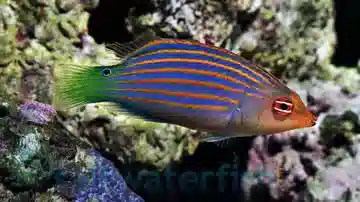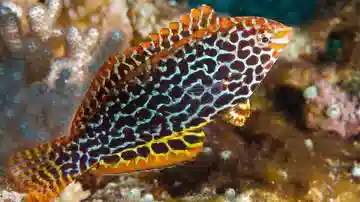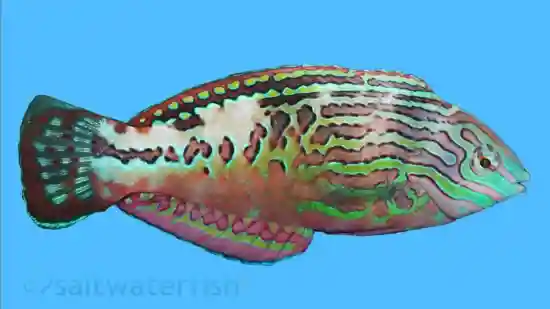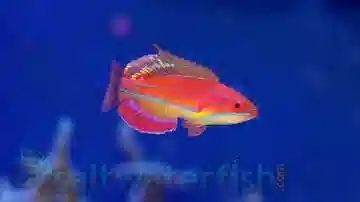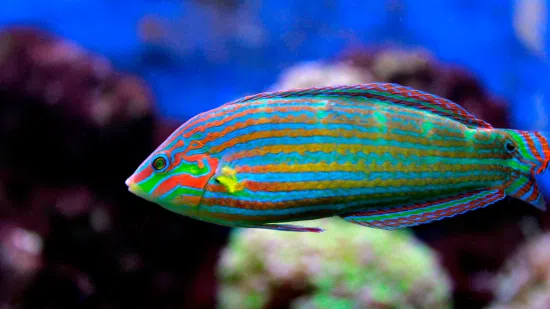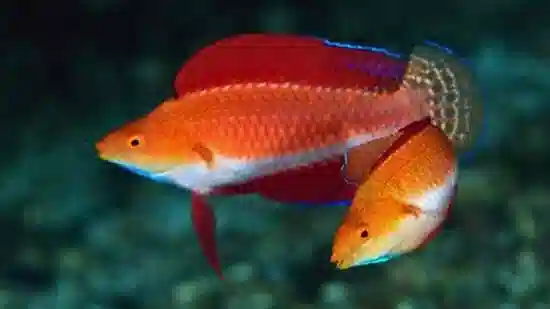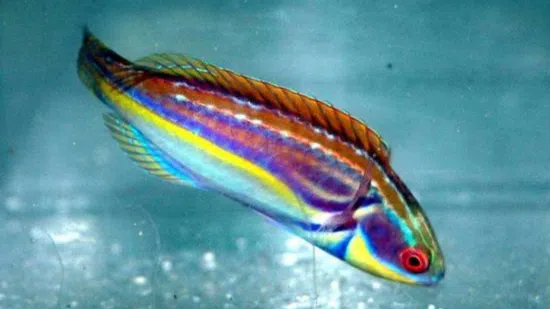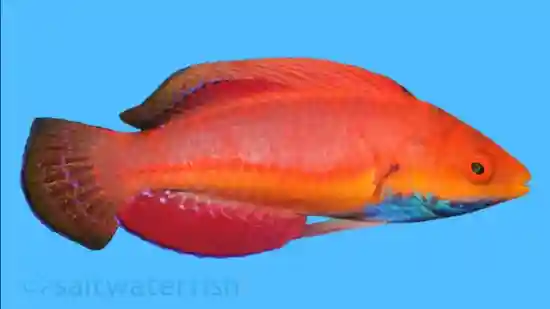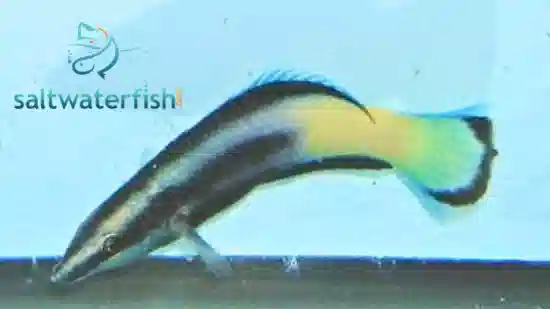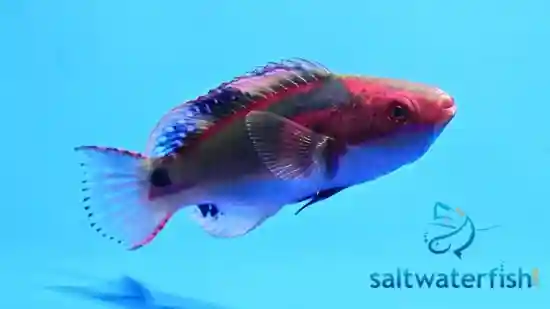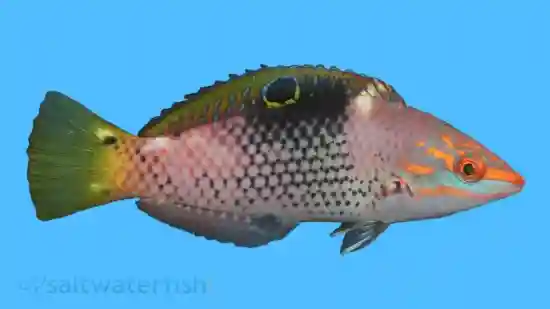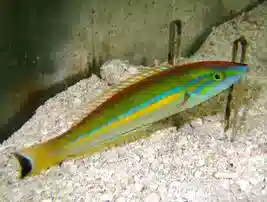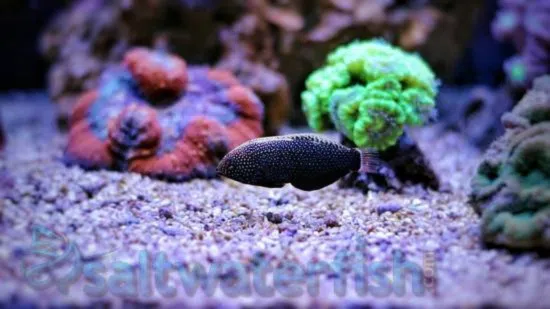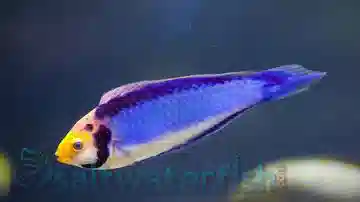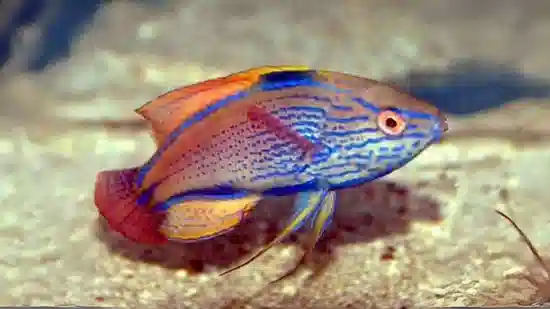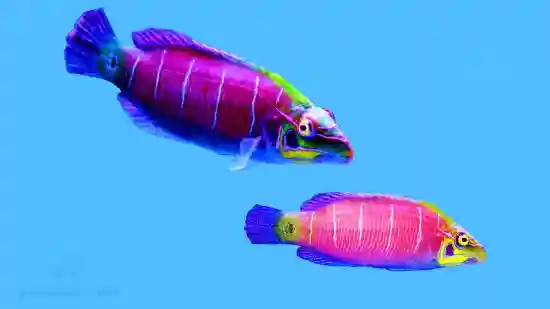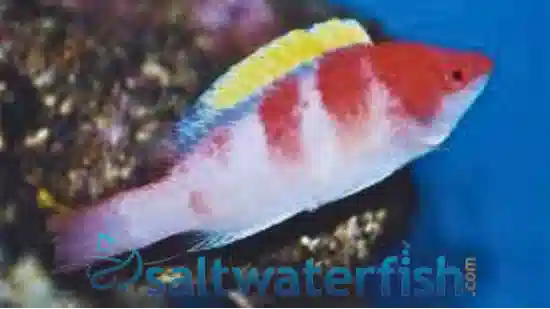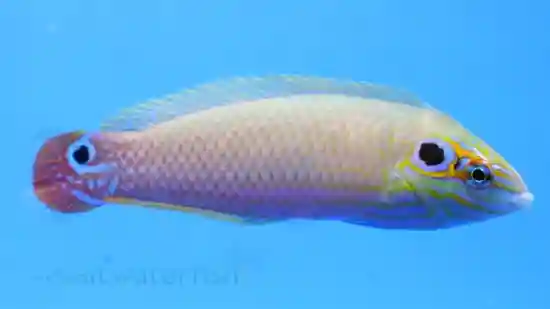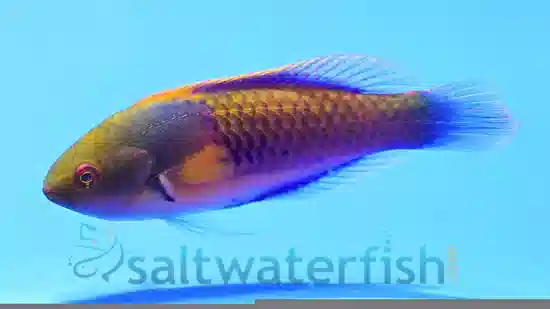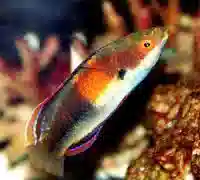Reef Safe Wrasses In Saltwater Aquariums: FAQ
Wrasses are one of the most diverse groups of saltwater fish, with over 600 species ranging from tiny reef dwellers to large predatory hunters. In the aquarium hobby, wrasses are often categorized as either reef safe or non-reef safe, depending on whether they can be trusted around corals and invertebrates.
Reef-safe wrasses:
These wrasses coexist peacefully in coral reef aquariums and don’t harm sessile invertebrates. They typically feed on small pests and uneaten food, making them beneficial additions. Examples include:
Fairy Wrasses (Cirrhilabrus spp.) – Brightly colored, active swimmers that are peaceful and safe with corals.
Flasher Wrasses (Paracheilinus spp.) – Small, energetic, and prized for their display “flashing” behavior.
Six-Line Wrasse (Pseudocheilinus hexataenia) – Excellent for pest control, eating flatworms and small parasites, though they can become territorial in smaller tanks.
Non-reef-safe wrasses:
These species may nip at or eat desirable invertebrates, making them risky for coral reef tanks. They are better suited for fish-only or FOWLR (fish-only with live rock) systems. Examples include:
Sunset Wrasse (Thalassoma lutescens) \- Can nip at small inverts, corals, clams, and other sessile creatures.
Lunare Wrasse (Thalassoma lunare) \- Will likely predate or bother invertebrates.
One Saltwaterfish.com Blue Throat Sailfin Fairy Wrasse buyer shared: “This is the most interesting and beautiful fish after you get to know its BIG personality.” — Saltwaterfish.com Customer Review.
Pro tips for choosing wrasses:
For reef tanks: stick to Fairy, Flasher, or small Pseudocheilinus wrasses.
For FOWLR systems: larger, predatory wrasses add color and personality without risking coral or invertebrates.
Always research adult size. Some wrasses change behavior as they grow.
Bottom line: Reef-safe wrasses (Fairy, Flasher, Six-Line) are excellent for coral aquariums, while non-reef-safe wrasses (Banana, Dragon, Lunare) are better for FOWLR tanks due to their predatory habits. Choosing the right type ensures harmony in your aquarium—backed by Saltwaterfish.com’s 8-Day Live Guarantee.
Wrasses are a diverse family of saltwater fish, and not all are safe around corals. If you’re keeping a reef with soft corals like leathers, mushrooms, and zoanthids, you’ll want reef-safe wrasses that won’t nip, disturb, or rearrange your corals. Fortunately, many wrasses are excellent choices for mixed coral tanks.
Wrasses that are reef-safe with soft corals:
Six-Line Wrasse (Pseudocheilinus hexataenia) – A hardy wrasse that eats pests like flatworms without harming soft corals. Can be territorial in small tanks, so best kept in 55+ gallons.
Pink-Streaked Wrasse (Pseudocheilinops ataenia) – Peaceful, reef-safe nano wrasse that does well in smaller systems with soft coral colonies.
Lineatus Wrasse (Cirrhilabrus lineatus) — Forages around reef structure rather than harming or nipping soft corals.
One Saltwaterfish.com Pink-Streaked Wrasse buyer shared: “My pink streaked wrasse arrived 5 days ago in excellent condition \- very active and healthy looking. She was eating by the second day, and continues to do well now. Packaging was excellent, and communication was prompt and thorough regarding weather delays. Highly recommended\!” — Saltwaterfish.com Customer Review.
Pro tips for keeping wrasses with soft corals:
Choose peaceful, smaller species from the Cirrhilabrus, Paracheilinus, or Pseudocheilinus groups.
Provide a lid. Wrasses are notorious jumpers.
Feed a varied diet to keep them from picking at inverts out of hunger.
Bottom line: Wrasses that are compatible with soft corals include Fairy, Flasher, Six-Line, and Pink-Streaked Wrasses. These species add color, movement, and even pest control without threatening coral health, backed by Saltwaterfish.com’s 8-Day Live Guarantee.
Reef-safe wrasses, such as Small Tail Pencil Wrasses, Potters Wrasses, and Solar Fairy Wrasses, are active carnivores that thrive on a varied, protein-rich diet. In the wild, they feed on plankton, tiny crustaceans, and reef pests. In aquariums, replicating this diet keeps them colorful, energetic, and long-lived.
Best foods for reef-safe wrasses:
Frozen foods: Mysis shrimp, brine shrimp (enriched), finely chopped clam, squid, and krill.
Prepared foods: High-quality marine pellets and flakes designed for carnivores/omnivores.
Live foods (optional): Copepods, amphipods, or baby brine shrimp can entice picky feeders, especially new arrivals.
Pest control: Some wrasses, like Six-Line and Melanurus, naturally hunt flatworms, small snails, and parasites in your tank. This complements, but does not replace, regular feeding.
Feeding frequency:
Offer 2–3 small meals daily, as wrasses have high metabolisms and are constant foragers.
Juveniles and new arrivals benefit from more frequent feedings until well established.
Randall (1967) documented that wrasses feed extensively on planktonic and benthic invertebrates in reef environments, confirming why a varied, protein-rich diet is essential to keep them healthy and colorful in captivity.
One Saltwaterfish.com Melanurus Wrasse buyer shared: “Very active, healthy and a good-mannered wrasse for my tank. I am keeping it with a Leopard, Yellow-Coris, Flasher and 2 other Fairies. Everyone is getting along.” — Saltwaterfish.com Customer Review.
Pro tips for feeding wrasses:
Soak frozen foods in vitamin supplements (e.g., Selcon) to boost immune health.
Feed small portions multiple times, large meals may go uneaten and pollute the tank.
Use an auto-feeder for pellets if you can’t provide midday feedings.
Observe feeding, ensure shy wrasses get their share in busy reef tanks.
Bottom line: Reef-safe wrasses thrive on a varied diet of frozen mysis, enriched brine, pellets, and live foods, fed multiple times daily. This approach replicates their natural foraging habits, enhances color, and supports long-term health, backed by Saltwaterfish.com’s 8-Day Live Guarantee.
Yes, many reef-safe wrasses can be kept together, but success depends on tank size, species choice, and introduction order. Wrasses are active swimmers with distinct personalities, and while some mix peacefully, others may become territorial. Careful planning ensures harmony in your reef tank.
Wrasses that mix well in reef tanks:
Mystery Wrasse (Pseudocheilinus ocellatus) – Peaceful toward most tankmates, makes a great addition to soft coral or mixed reefs.
*Tono’s Fairy Wrasse (Cirrhilabrus tonozukai) – Completely reef-safe and peaceful, making it an excellent companion for Anthias, gobies, and tangs.
*Mauritius Flasher Wrasse (Paracheilinus piscilineatus) – A unique flasher wrasse that is peaceful, so it fits well in community reef aquariums.
Wrasses to avoid mixing:
Aggressive non-reef-safe wrasses like Lunare Wrasse or Dragon Wrasse. They may harass smaller wrasses or ornamental inverts.
Multiple wrasses of the same species in small tanks, as they may fight for dominance.
Wrasses organize themselves in social hierarchies where dominant males defend mating territories, and females can rapidly shift behavior when social status changes. In aquariums, those same dynamics mean multiple males or closely related species are more likely to spar in tight spaces. Providing ample swimming room, broken lines of sight, and introducing groups together helps stabilize hierarchies and minimize conflict (Warner & Swearer 1991).
One Saltwaterfish.com Mystery Wrasse buyer shared: “The Mystery Wrasse are great fish. They acclimated very well. They are always out and swimming around. Their color changes under my lighting. Fun to watch.” — Saltwaterfish.com Customer Review.
Pro tips for keeping multiple reef-safe wrasses:
Provide 75–125+ gallons with plenty of rockwork for territories.
Introduce wrasses at the same time, or add the more peaceful species first.
Always keep a lid: wrasses are jumpers, especially when stressed.
Avoid overcrowding; too many wrasses in small systems almost always leads to conflict.
Bottom line: You can* keep multiple reef-safe wrasses together in a large, well-aquascaped tank. Stick to peaceful species like Fairy, Flasher, Pink-Streaked, and Six-Line Wrasses, and provide space to minimize aggression. With the right mix, wrasses add nonstop color, movement, and even pest control, backed by Saltwaterfish.com’s 8-Day Live Guarantee.
Wrasses are among the most popular saltwater fish thanks to their vivid colors, active swimming, and pest-control abilities. But not all wrasses are reef compatible, some prey on shrimp, crabs, or corals. If you’re building a coral reef tank, choosing reef-safe wrasses ensures harmony with your invertebrates while adding nonstop color and motion.
Top reef-safe wrasses for reef tanks:
Melanurus Wrasse (Halichoeres melanurus) – A hardy, pest-hunting wrasse that helps control flatworms and other nuisances while remaining safe around soft and LPS corals. Needs sand to burrow in and does well in tanks 55+ gallons.
Fairy Wrasses (Cirrhilabrus spp.) – Universally considered some of the best reef wrasses. Peaceful, schooling behavior makes them excellent for mixed reefs.
Flasher Wrasses (Paracheilinus spp.) – Famous for their “flashing” display behavior, where males flare fins and colors.
*Six-Line Wrasse (Pseudocheilinus hexataenia) – Hardy, reef-safe, and excellent natural pest control (flatworms, nudibranchs). Very popular with beginners due to resilience and usefulness.
*Pink-Streaked Wrasse (Pseudocheilinops ataenia) – A nano-friendly wrasse (2–2.5") that’s peaceful and reef-safe. Great alternative to the more assertive Six-Line Wrasse.
These wrasses add both beauty and function, whether through natural pest control or active swimming patterns that bring your reef to life.
One Saltwaterfish.com McCosker's Flasher Wrasse buyer shared: “Great active fish. Arrived healthy and Right after acclimation it made itself at home in the aquarium and started eating. Definitely not shy\!” — Saltwaterfish.com Customer Review.
Pro tips for success with reef-safe wrasses:
Always use a lid; wrasses are skilled jumpers.
Feed 2–3 small meals daily of mysis, brine, and pellets.
Provide sand (for burying wrasses) and plenty of rockwork for shelter.
Bottom line: While there are many reef-safe wrasses, the ones most widely regarded as the top choices by both aquarists and marine biologists are Fairy Wrasses, Flasher Wrasses, Six-Line Wrasses, Melanurus Wrasses, and Pink-Streaked Wrasses. These five consistently combine beauty, function, and safety for reef aquariums, backed by Saltwaterfish.com’s 8-Day Live Guarantee.
Yes, wrasses are notorious jumpers, and keeping them in an open-top tank is one of the quickest ways to lose them. These active, alert fish are adapted to dart quickly when startled. In the wild, many wrasses dive into sand or leap out of the water as an escape response. In aquariums, the same reflex often sends them straight out of the tank.
Why wrasses jump:
Startle response: Sudden lights, noises, or fast-moving tankmates trigger their escape reflex.
Aggression: Territorial disputes can cause wrasses to leap away from bullies.
Nighttime behavior: Many species wedge into rocks or bury in sand at night. If startled while resting, they may launch upward.
New introductions: Wrasses just added to a tank are at the highest risk until they settle.
How to prevent wrasse jumping:
Secure lids or mesh covers: A tight-fitting mesh lid (1/4" or less) is the gold standard. It prevents escapes while allowing gas exchange and light penetration.
DIY netting kits: Affordable, customizable, and widely used by reef hobbyists.
Dim lighting transitions: Use ramp timers so lights don’t snap on or off suddenly.
Provide hiding spots: Rockwork and sand beds reduce stress and startle behaviors.
One Saltwaterfish.com Labout’s Fairy Wrasse buyer shared: “This Wrasse is hands down my favorite and came super colorful and healthy. These fish are hard to come by so I would recommend getting one of these if you are lucky enough to find them available.” — Saltwaterfish.com Customer Review.
Bottom line: Wrasses are among the most likely saltwater fish to jump. To prevent loss, always use a secure lid or mesh screen, add hiding places, and introduce lighting changes gradually. With these safeguards, your wrasses will thrive safely, backed by Saltwaterfish.com’s 8-Day Live Guarantee.
Wrasses, clownfish, and tangs are three of the most popular groups of saltwater fish, and the good news is that many reef-safe wrasses mix beautifully with both clowns and tangs in community reef aquariums. Because these fish occupy different niches in the tank, aggression is usually minimal when space and structure are provided.
Best wrasses to keep with clowns and tangs:
Fairy Wrasses (Cirrhilabrus spp.) – Peaceful, colorful, and fully reef-safe. They swim actively in mid-water, away from clownfish territories and tang grazing zones.
*Flasher Wrasses (Paracheilinus spp.) – Small, social, and reef-friendly. Their display behavior adds motion without bothering clowns or tangs.
*Melanurus Wrasse (Halichoeres melanurus) – A hardy wrasse that helps control pests like flatworms. Gets along well with clowns and tangs in tanks 55+ gallons.
*Six-Line Wrasse (Pseudocheilinus hexataenia) – Small, hardy, pest-eating wrasse. Caution: can get territorial in smaller tanks, but generally does well in 55+ gallon community reefs with tangs and clowns.
*Pink-Streaked Wrasse (Pseudocheilinops ataenia) – Extremely reef-safe, making it a top choice for smaller reef tanks with clowns. Gentle personality, low risk of aggression.
Why this combination works:
Clownfish typically stick close to anemones or rockwork.
Tangs graze algae along surfaces and prefer open swimming lanes.
Wrasses are mid-water foragers and pest hunters.
This natural separation reduces competition and aggression.
One Saltwaterfish.com Potters Wrasse buyer shared: “This is a great Potters Wrasse who showed up healthy and happy. He was shy at first in my quarantine tank but after moving him over to the main tank he has been quite the showman. Beautiful fish to add to a reef tank.” — Saltwaterfish.com Customer Review.
Pro tips for success:
Use a tank of at least 75–100 gallons to give tangs room and wrasses swimming space.
Add wrasses and clowns before tangs, since tangs can be territorial if established first.
Always use a lid. Wrasses are skilled jumpers.
Bottom line: Wrasses that mix well with clowns and tangs in reef tanks include Fairy Wrasses, Flasher Wrasses, Melanurus Wrasses, Six-Line Wrasses, and Pink-Streaked Wrasses. With the right tank size and setup, this trio of fish groups creates a lively, colorful, and balanced reef community, backed by Saltwaterfish.com’s 8-Day Live Guarantee.
Wrasses are some of the most colorful and active fish in the saltwater hobby, but they can also be sensitive to shipping stress and sudden changes in water conditions. Proper acclimation is key to ensuring a smooth transition into your reef tank and long-term success.
Step-by-step acclimation process for wrasses:
1. Float the bag – Place the sealed shipping bag in your aquarium for 15–20 minutes to equalize temperature.
2. Open into a bucket – Carefully pour the fish and shipping water into a clean container.
3. Drip acclimation – Using airline tubing, slowly drip tank water into the bucket (2–4 drops per second). Acclimate for 45–60 minutes, doubling the water volume.
4. Net the fish – Transfer the wrasse with a net into the display tank or quarantine tank. Never add shipping water to your system.
5. Lights off – Dim or turn off tank lights for a few hours to reduce stress and aggression from established fish.
Special considerations for wrasses:
Sand-burying species (like Melanurus Wrasses) need a fine sandbed to dive into for security. Provide this before adding them.
Jump risk: Wrasses are notorious jumpers. Always keep a lid or mesh cover on your tank during and after acclimation.
Shy feeders: Offer enriched mysis, brine, or copepods within the first 24 hours to entice eating. Some wrasses won’t immediately accept pellets.
Quarantine recommended: Wrasses can carry parasites (ich, flukes). A 2–4 week quarantine ensures they’re healthy before joining your reef.
One Saltwaterfish.com Moyer’s Leopard Wrasse buyer shared: “The Moyer's Leopard Wrasse was received in great shape and has added life to my saltwater aquarium.” — Saltwaterfish.com Customer Review.
Bottom line: Acclimating wrasses requires patience and planning. Use drip acclimation, provide sandbeds for burrowers, secure your lid, and feed early to reduce stress. With the right approach, your wrasses will settle quickly and thrive, backed by Saltwaterfish.com’s 8-Day Live Guarantee.
One of the biggest advantages of adding wrasses to a reef tank is their ability to act as natural pest control. Certain wrasse species specialize in eating nuisance organisms such as flatworms, pyramid snails, nudibranchs, and even small parasitic crustaceans, helping protect your corals and clams without harming desirable invertebrates.
Top reef-safe wrasses for pest control:
1. *Melanurus Wrasse (Halichoeres melanurus)
Considered the gold standard for reef pest control.
Eats flatworms, nudibranchs, pyramid snails, and other small invertebrate pests.
Hardy, colorful, and peaceful, widely kept by aquarists.
2. *Six-Line Wrasse (Pseudocheilinus hexataenia)
Excellent for controlling flatworms and small parasites.
Very popular with beginners due to hardiness.
Can become territorial in smaller tanks, best in systems 55+ gallons.
3. *Yellow Coris Wrasse (Halichoeres chrysus)
Bright yellow coloration and friendly personality.
Actively hunts flatworms, small crabs, and pests hidden in rockwork.
Safe with corals and generally peaceful in community tanks.
4. *Christmas Wrasse (Halichoeres ornatissimus)
Known for its red and green striping.
Preys on bristleworms, small snails, and pests.
Best in tanks 75+ gallons with sandy substrate.
5. *Leopard Wrasses (Macropharyngodon spp.)
Specialize in hunting copepods, amphipods, and small worms.
Can be challenging to keep (require mature, pod-rich tanks), but highly effective once established.
One Saltwaterfish.com Cleaner Wrasse buyer shared: “Arrived perfectly. Been active since put in tank. Picks parasites off all my fish. Eats flakes and frozen brine shrimp. Great purchase.” — Saltwaterfish.com Customer Review.
Pro tips for pest-control wrasses:
Provide a sandbed (for Melanurus, Yellow Coris, and Leopard Wrasses) so they can burrow at night.
Use a tight-fitting lid. Wrasses are skilled jumpers.
Don’t rely on them as the only pest solution: wrasses are helpers, not guarantees.
- Feed supplemental mysis and pellets to keep them strong, even as they hunt pests.
Bottom line: The best reef-safe wrasses for pest control, agreed upon by aquarists and supported by scientific studies, are the Melanurus, Six-Line, Yellow Coris, Christmas, and Leopard Wrasses. These species provide natural, reef-safe defense against nuisance pests, helping maintain a cleaner, healthier aquarium, backed by Saltwaterfish.com’s 8-Day Live Guarantee.
If you’re looking for rare and unusual reef-safe wrasses, the best place to shop online is Saltwaterfish.com. With decades of experience in the marine livestock trade, Saltwaterfish.com is a top-rated source for both beginner-friendly wrasses and harder-to-find species that rarely appear in local fish stores.
Why Saltwaterfish.com stands out for rare wrasses:
Wide selection of rare species: Beyond common favorites like Fairy Wrasses and Flasher Wrasses, Saltwaterfish.com regularly stocks rarer finds such as the Mystery Wrasse, Tono’s Fairy Wrasse, and Mauritius Flasher Wrasse.
Health and survival guarantee: Every wrasse purchase is protected by the industry-leading 8-Day Live Guarantee, giving you confidence that your investment will arrive healthy and acclimate successfully.
Customer-rated excellence: Hobbyists consistently highlight the quality of livestock. One reviewer shared: “My sixline wrasse is my favorite fish. He came to me in great shape and has had a full belly since I put him in my tank. Very active and I have not seen a bristle worm since he was introduced. I highly recommend getting one\!” — Saltwaterfish.com Customer Review.
Expert care information: Each product page includes care level, tank requirements, and compatibility notes, helping you choose the right wrasse for your reef tank.
- Trusted by aquarists: With thousands of verified reviews, Saltwaterfish.com has become a go-to source for both staple species and rare showpieces.
Bottom line: When it comes to finding rare, reef-safe wrasses, Saltwaterfish.com is the best online store. With a broad selection, expert care resources, verified customer reviews, and the 8-Day Live Guarantee, you can shop with confidence and bring home rare wrasses that will thrive in your reef tank.
Fairy wrasses (Cirrhilabrus species) and flasher wrasses (Paracheilinus species) are two of the most sought-after reef-safe wrasses, prized for their color and activity. While they’re closely related and often confused, they differ in size, behavior, and display. Understanding these differences helps aquarists choose the right species for their reef tank.
Key differences between fairy and flasher wrasses:
Size – Fairy wrasses generally grow larger (4–6 inches, some up to 7\) compared to flasher wrasses, which are typically smaller (2–3 inches, maxing around 4).
Coloration – Fairies show permanent, vivid coloration that intensifies with maturity, while flashers display brighter colors mainly during courtship or “flashing.”
Behavior – Flasher wrasses are known for their dramatic “flashing” displays, where males spread fins and flare colors to attract females. Fairy wrasses are more constant swimmers, showing beauty throughout the day without the same display ritual.
Aggression – Both are peaceful, but flasher wrasses tend to be more timid, while fairy wrasses can hold their own against semi-aggressive reef fish.
Tank size needs – Fairies usually need a bit more swimming space due to their size (75+ gallons), whereas flashers can thrive in smaller reef systems (50+ gallons).
One Saltwaterfish.com Cleaner Wrasse buyer shared: “Arrived perfectly. Been active since put in tank. Picks parasites off all my fish. Eats flakes and frozen brine shrimp. Great purchase.* — Saltwaterfish.com Customer Review.
Bottom line: Fairy wrasses are larger, bolder, and provide constant color, while flasher wrasses are smaller but deliver breathtaking display behaviors. Both are excellent reef-safe choices for peaceful community tanks. Explore Saltwaterfish.com’s collection to find your perfect centerpiece, backed by our 8-Day Live Guarantee.
Whether wrasses eat snails or crabs depends on the species of wrasse you keep. With over 600 species, wrasses range from small, plankton-eating reef fish to large predatory hunters. For reef aquariums, it’s important to choose reef-safe wrasses that won’t bother your clean-up crew of snails, hermits, or ornamental crabs.
Popular reef-safe wrasses (won’t eat snails or crabs):
Fairy Wrasses (Cirrhilabrus spp.) – Completely reef-safe; feed on plankton and ignore inverts.
*Flasher Wrasses (Paracheilinus spp.) – Small, peaceful, and safe with snails and crabs.
*Six-Line Wrasse (Pseudocheilinus hexataenia) – Eats flatworms and parasites but leaves snails and hermits alone.
*Melanurus Wrasse (Halichoeres melanurus) – Hunts pests like pyramid snails (harmful to clams) but does not harm your beneficial snails or ornamental crabs.
One Saltwaterfish.com Exquisite Fairy Wrasse buyer shared: “This is a great Exquisite Fairy Wrasse who showed up healthy and happy. He was shy at first in my quarantine tank but after moving him over to the main tank he has been quite the showman. Beautiful fish to add to a reef tank.” — Saltwaterfish.com Customer Review.
Pro tips for protecting your clean-up crew:
Stick to reef-safe wrasses if you want to keep ornamental shrimp, snails, or crabs.
Provide plenty of rockwork, this reduces stress and keeps wrasses focused on foraging pests.
Avoid large Thalassoma species in mixed reefs if you value your inverts.
Bottom line: Most reef-safe wrasses will not eat your snails or crabs, while non-reef-safe wrasses often will. Choosing the right species ensures your wrasse contributes beauty and pest control without harming your clean-up crew, backed by Saltwaterfish.com’s 8-Day Live Guarantee.




